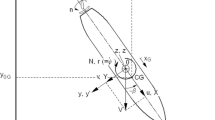Abstract
To assess the manoeuvrability of ships at the early design stage, reliable simulation models are required. Traditionally, these tools have used empiric descriptions of the forces and moments on the ship’s hull. However, nowadays new computational techniques are available enabling more reliable predictions of the manoeuvring behaviour of ships. In this article, a mathematical manoeuvring model to predict the forces and moments on a bare ship hull is presented. Special attention is paid to application in simulators in which also astern or sideways manoeuvring should be possible. The hydrodynamic derivatives in this model were determined by a hybrid approach using results of viscous flow calculations supplemented by semi-empirical methods. It was demonstrated that this approach leads to a considerable improvement in the prediction of the forces and moments on the ship compared to using conventional empiric derivatives published in the literature.








Similar content being viewed by others
References
International Maritime Organisation (2002) IMO resolution MSC. 137(76): Standards for ship manoeuvrability, International Maritime Organisation, London
Quadvlieg FHHA, Van Coevorden P (2003) Manoeuvring criteria: more than IMO A751 requirements alone! In: Proceedings of the MARSIM international conference on marine simulation and ship manoeuvrability, vol 2. The Society of Naval Architects of Japan and Japan Institute of Navigation, Kanazawa
Dand I (2003) Low-speed manoeuvring criteria: some considerations. In: Proceedings of the MARSIM international conference on marine simulation and ship manoeuvrability, vol 1. The Society of Naval Architects of Japan and Japan Institute of Navigation, Kanazawa
Cura Hochbaum A, Vogt M (2003) On the prediction of hydrodynamic forces on a manoeuvring ship. In: Proceedings of the MARSIM international conference on marine simulation and ship manoeuvrability, vol 3. The Society of Naval Architects of Japan and Japan Institute of Navigation, Kanazawa
Ohmori T (1998) A study on hydrodynamic characteristics of a maneuvering ship in shallow water by a finite-volume method. In: MAN’98 international symposium and workshop on force acting on a maneuvering vessel, Bassin d’Essais des Carènes, Val de Reuil, France
Jurgens AJ, Hallmann R, Tukker J (2006) Experimental investigation into the flow around a manoeuvring LNG carrier on shallow water. In: Proceedings of the NAV international conference on ship and shipping research, Cetena, Genova
Hino T (ed) (2005) Proceedings of the CFD workshop, National Maritime Research Institute, Tokyo
Hoekstra M (1999) Numerical simulation of ship stern flows with a space-marching Navier–Stokes method. PhD thesis, Faculty of Mechanical Engineering and Marine Technology, Delft University of Technology
Raven HC, van der Ploeg A, Eça L (2006) Extending the benefit of CFD tools in ship design and performance prediction. In: Proceedings of the seventh ICHD international conference on hydrodynamics, University of Naples “Federico II”, Ischia, pp 573–580
Menter FR (1997) Eddy viscosity transport equations and their relation to the k–ε model. J Fluid Eng 119:876–884
Dacles-Mariani J, Zilliac GG, Chow JS, Bradshaw P (1995) Numerical/experimental study of a wing tip vortex in the near field. AIAA J 33:1561–1568
Eça L, Hoekstra M, Windt J (2002) Practical grid generation tools with applications to ship hydrodynamics. In: Proceedings of the eighth international conference on grid generation in computational field simulations
Toxopeus SL (2005) Verification and validation of calculations of the viscous flow around KVLCC2M in oblique motion. In: Proceedings of the fifth Osaka colloquium, Osaka Prefecture University, Osaka, pp 200–209
Toxopeus SL (2006) Calculation of hydrodynamic manoeuvring coefficients using viscous-flow calculations. In: Proceedings of the seventh ICHD international conference on hydrodynamics, University of Naples “Federico II”, Ischia, pp 493–502
Vassalos D, Park SH, Lee BS (1995) Developing a manoeuvring design capability for naval vessels. In: Proceedings of the PRADS practical design of ships and other floating bodies conference, Seoul, pp 1.616–1.617
Ishiguro T, Tanaka S, Yoshimura Y (1996) A study on the accuracy of the recent prediction technique of ship’s manoeuvrability at the early design stage. In: Proceedings of the MARSIM international conference on marine simulation and ship manoeuvring, Danish Maritime Institute, Copenhagen, pp 547–561
Lee H-Y, Shin S-S (1998) The prediction of ship’s manoeuvring performance in the initial design stage. In: Proceedings of the PRADS practical design of ships and other floating bodies conference, Maritime Research Institute Netherlands, The Hague, pp 633–639
Bulian G, Nicolosi RG, Francescutto A (2006) On the effect of uncertainty modeling in the hydrodynamic derivatives of a ship manoeuvring mathematical model. In: Proceedings of the seventh ICHD international conference on hydrodynamics, University of Naples “Federico II”, Ischia, pp 359–368
Clarke D, Gedling P, Hine G (1983) The application of manoeuvring criteria in hull design using linear theory. Trans RINA 125:45–68
Hooft JP, Pieffers JBM (1988) Maneuverability of frigates in waves. Mar Technol 25(4):262–271
Hooft JP (1994) The cross flow drag on a manoeuvring ship. Ocean Eng 21(3):329–342
Kume K, Hasegawa J, Tsukada Y et al (2006) Measurements of hydrodynamic forces, surface pressure, and wake for obliquely towed tanker model and uncertainty analysis for CFD validation. J Mar Sci Technol 11:65–75
Kijima K, Nakiri Y, Furukawa Y (2000) On a prediction method for ship manoeuvrability. In: Proceedings of the international workshop on ship manoeuvrability-25 years CPMC at HSVA, Hamburg
Toxopeus SL (2006) Validation of slender-body method for prediction of linear manoeuvring coefficients using experiments and viscous-flow calculations. In: Proceedings of the seventh ICHD international conference on hydrodynamics, University of Naples “Federico II”, Ischia, pp 589–598
Acknowledgments
Part of the work conducted for this article was funded by the Commission of the European Communities for the Integrated Project VIRTUE under grant 516201 in the sixth Research and Technological Development Framework Programme (Surface Transport Call).
Author information
Authors and Affiliations
Corresponding author
About this article
Cite this article
Toxopeus, S.L. Deriving mathematical manoeuvring models for bare ship hulls using viscous flow calculations. J Mar Sci Technol 14, 30–38 (2009). https://doi.org/10.1007/s00773-008-0002-9
Received:
Accepted:
Published:
Issue Date:
DOI: https://doi.org/10.1007/s00773-008-0002-9




